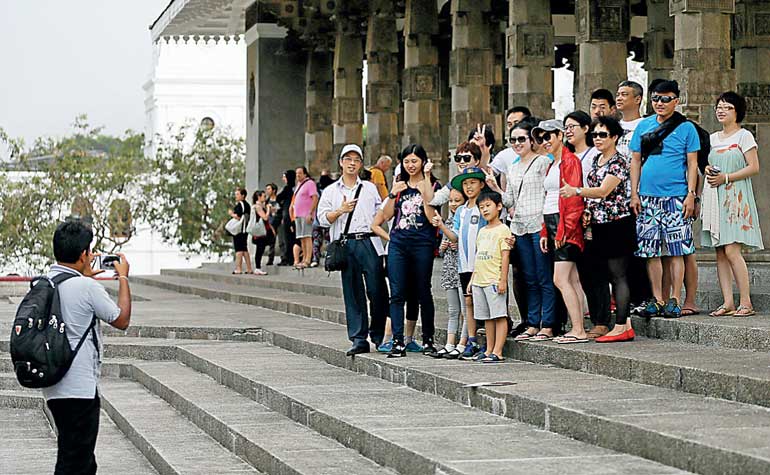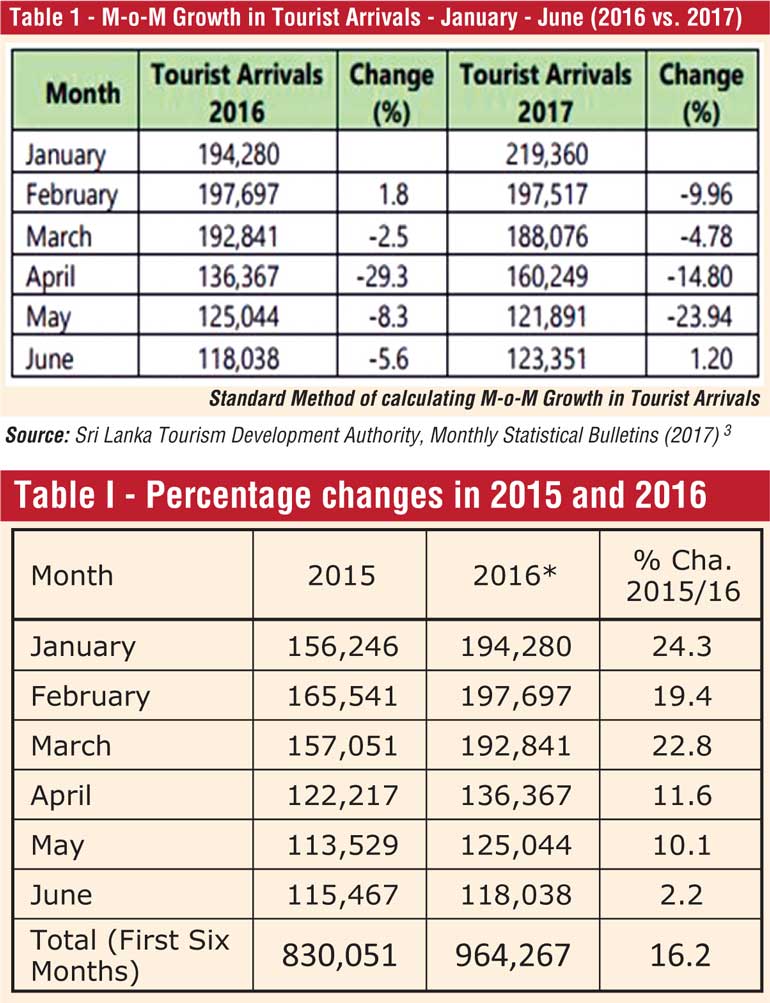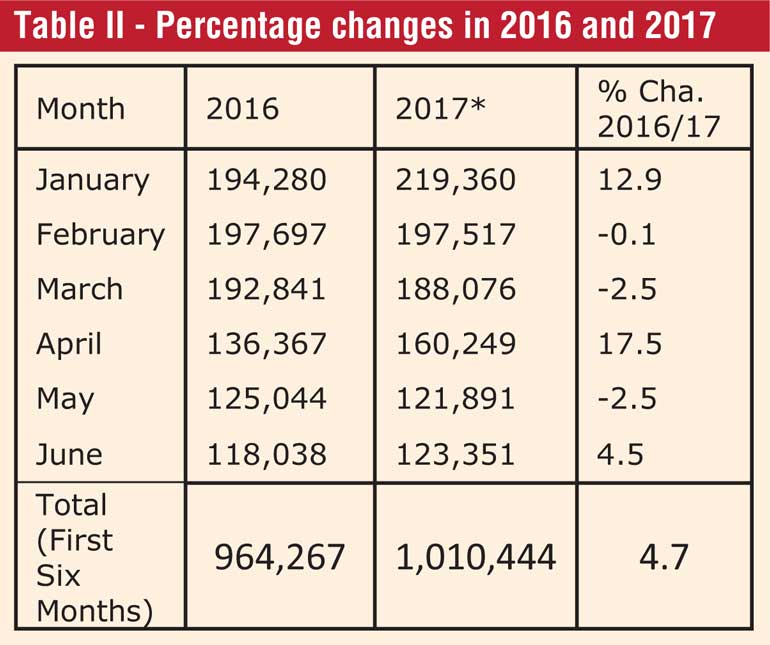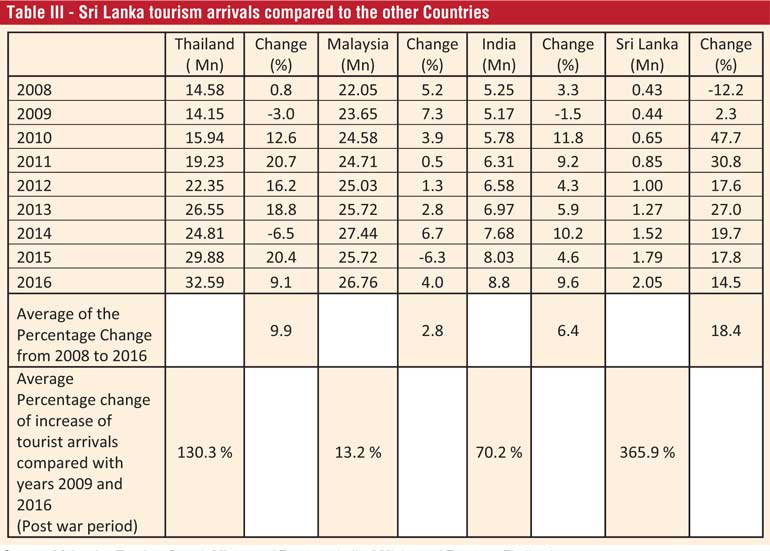Saturday Mar 15, 2025
Saturday Mar 15, 2025
Friday, 20 October 2017 00:00 - - {{hitsCtrl.values.hits}}



 The Sri Lanka Tourism Development Authority (SLTDA) in a statement recently highlighted the following points to refute the findings made against the statistics compiled by the organisation:
The Sri Lanka Tourism Development Authority (SLTDA) in a statement recently highlighted the following points to refute the findings made against the statistics compiled by the organisation:
The relevant data with regard to tourist arrivals is obtained by SLTDA from the Electronic Travel Authorisation (ETA) system of Department of Immigration and Emigration. Though the arrival data is utilised, only the relevant categories are taken into account that are within the definition, while other categories are excluded from the statistics. Therefore, utilisation of such selected data cannot be considered as problematic.
As mentioned in the report, the survey is conducted not solely to capture earnings. There are other objectives as well. However, the survey is not the primary instrument used to formulate the tourism earnings number. Average duration and arrivals are mainly based on the data obtained from the Department of Immigration and Emigration.
In terms of the issue of the sample, it is important to highlight the fact that the selection of the sample is not totally based on the number of arrivals from respective countries. While the base of the sample is selected from a stratified sampling method it is further calculated from a model which considers the expenditure patterns of the tourist as well. Strict procedures are followed to ensure error free data and reliability tests and program validation checks are applied at the end. The rationale in selecting the relevant sample sizes from Germany and UK against India and China is rather profound than the more visible factor of the arrivals.
The data captured in the questionnaire is basically based on the 37 questions included in the questionnaire. They have been included to capture a holistic picture. However, the questionnaires are being revised on yearly basis according to the market research needs.
The questions on spending have been included to get an overall idea and not to dig into details about the expenditure of the tourists. Including such lengthy information in the survey questionnaire will not be effective in generating valid data. It is expected to obtain such detailed information from Tourism Satellite Accounting system. The preparations are already underway to conduct certain surveys for the Tourism Satellite Accounting in collaboration with Department of Census and Statistics and Central Bank of Sri Lanka.
The rationale of collecting separate data on transit passengers in this survey is that their input is also vital in terms of marketing information. Therefore, it is difficult to ignore their contribution in this regard.
Apart from the above factors the following points should be raised with regard to the methodology used for the research report of Ceylon Chamber of Commerce.
There is a serious issue of validity in generalising the research findings to the tourism industry of Sri Lanka, given the fact that the sample consists of only 15 in depth interviews with industry leaders and a survey of 37 industry players from limited fields whereas the tourism industry consists of 3,549 registered establishments (with SLTDA) including registered accommodations, travel agencies, restaurants, spice gardens, tourist shops, etc. Furthermore, there is no indication of these 37 industry players though the list of industry leaders has been provided. Therefore, there is a serious flaw in the methodology used for the study, which brings the authenticity of the “study” into serious question. In other words, the selection of sample and the sample size does not indicate the application of accepted scientific methods. On the surface, the content of the report seems to be a manifestation of personal opinion of the few industry stakeholders consulted.
Scientific method in research is a systematic approach to researching questions and problems through objective and accurate observation, collection and analysis of data, direct experimentation and replication of these procedures. Yet it is clearly evident that the research is subjective and biased.
The standard way of calculating the month on month growth in arrivals in many countries is by comparing the percentage changes with the corresponding month of the previous year, due to variations in tourist arrivals (peak and off peak months) that characterise the industry. Sri Lanka being a seasonal destination the above practice is the most applicable method. Yet it was noticed that in Table No. 1 the calculations of month on month growth in tourist arrivals have been calculated by considering the % change from the previous month in the same year. This type of calculation misinterprets the real situation while creating a distorted picture about the growth. Therefore, this cannot be considered as an accurate way of analysis. The below table I & II provides an authentic depiction of the M-o-M growth in arrivals.
The below Table No.iii depicts the international tourist markets in comparison to Sri Lanka. A closer look at the figures reveals that Sri Lanka has the highest average percentage change from 2008 to 2016 which indicates to the fact that Sri Lanka has a sound industry when compared to other countries such as Thailand, Malaysia and India which maintains a robust industry. A considerable growth can be seen from 2009-2016. Therefore, when considered the percentage change it is clear that Sri Lanka has achieved the highest average percentage growth of 18.4% among the countries compared. Further, Sri Lanka has achieved the highest average percentage change of increase of arrivals in 2009 and 2016, compared with the same countries in the list. Therefore, it is incorrect and misleading to conclude that Sri Lanka has fallen behind without a valid base to support the argument.
Constructive evaluation is a necessary component to evaluate and improve the performance of an institution or an industry. Yet these should be based on authentic and credible information. In the absence of credibility such evaluations can be considered as assessments that lack rigour. We would also like to bring to your notice that the Special Committee Report on Revisions of New Tourism Law (2006) highlighted that both UNWTO and PATA have recognised the Sri Lanka Tourism’s basic tourism data system as one of the best systems in the world. Further this system continues to improve with modern techniques for collating tourist information.
Discover Kapruka, the leading online shopping platform in Sri Lanka, where you can conveniently send Gifts and Flowers to your loved ones for any event including Valentine ’s Day. Explore a wide range of popular Shopping Categories on Kapruka, including Toys, Groceries, Electronics, Birthday Cakes, Fruits, Chocolates, Flower Bouquets, Clothing, Watches, Lingerie, Gift Sets and Jewellery. Also if you’re interested in selling with Kapruka, Partner Central by Kapruka is the best solution to start with. Moreover, through Kapruka Global Shop, you can also enjoy the convenience of purchasing products from renowned platforms like Amazon and eBay and have them delivered to Sri Lanka.
Discover Kapruka, the leading online shopping platform in Sri Lanka, where you can conveniently send Gifts and Flowers to your loved ones for any event including Valentine ’s Day. Explore a wide range of popular Shopping Categories on Kapruka, including Toys, Groceries, Electronics, Birthday Cakes, Fruits, Chocolates, Flower Bouquets, Clothing, Watches, Lingerie, Gift Sets and Jewellery. Also if you’re interested in selling with Kapruka, Partner Central by Kapruka is the best solution to start with. Moreover, through Kapruka Global Shop, you can also enjoy the convenience of purchasing products from renowned platforms like Amazon and eBay and have them delivered to Sri Lanka.